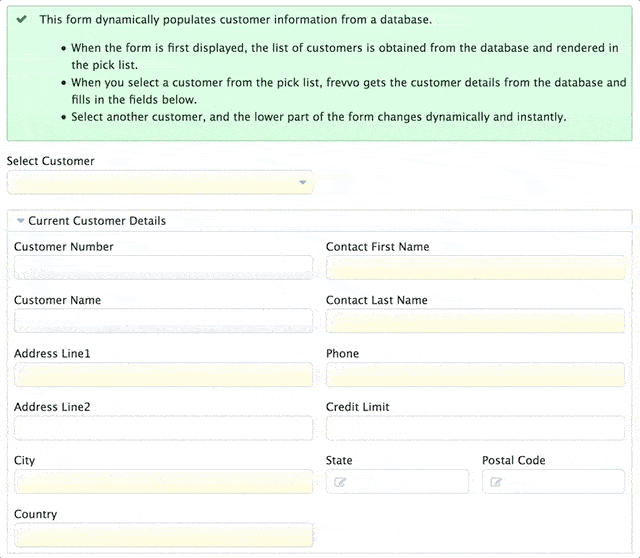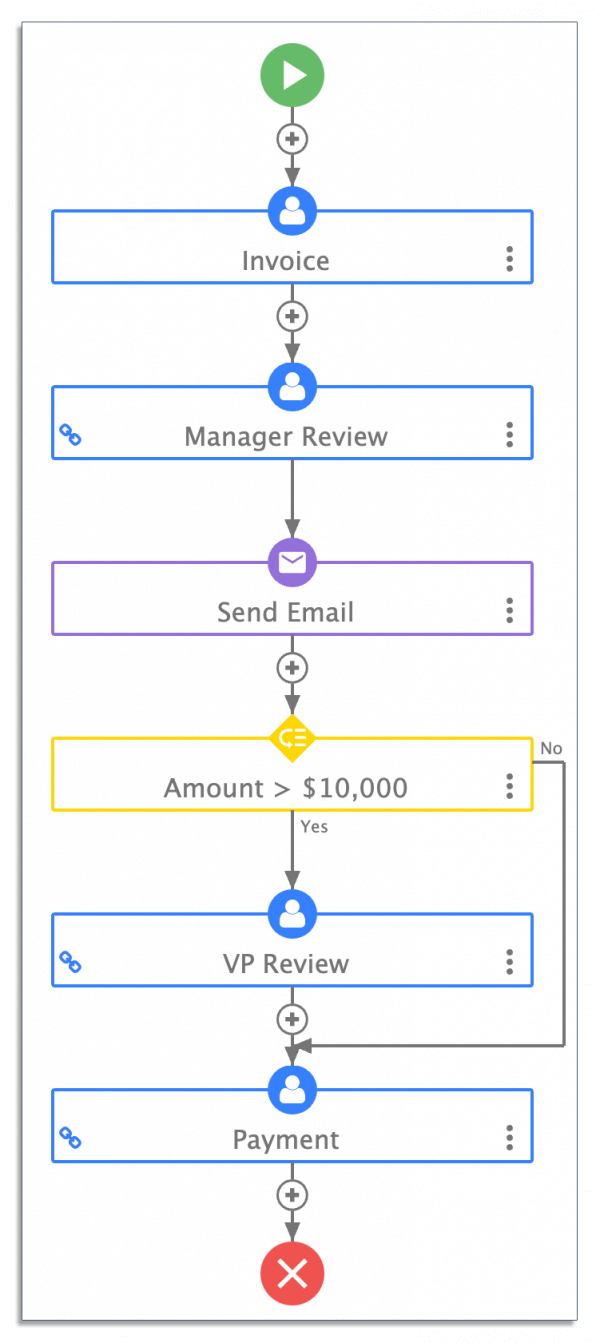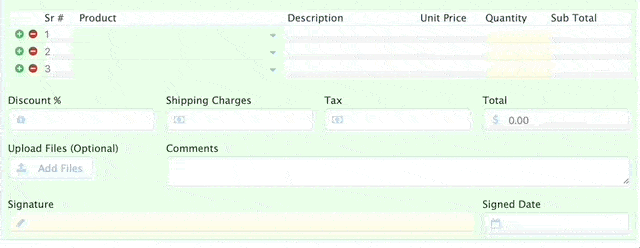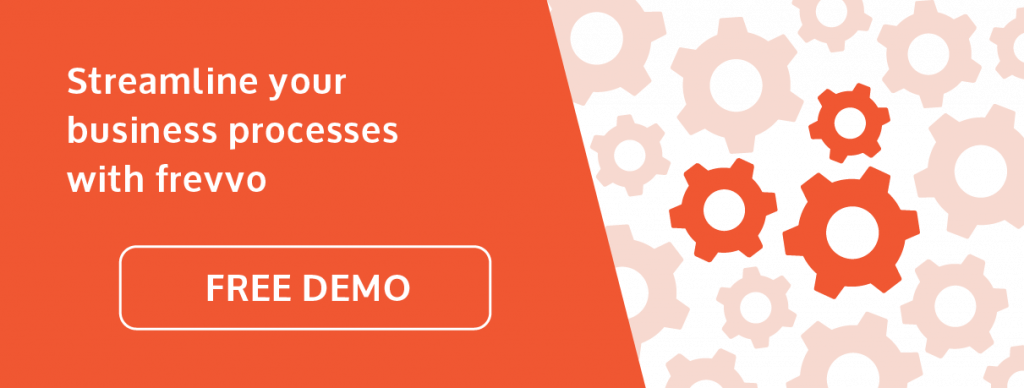Your company has dozens or even hundreds of processes.
However, these processes can become inefficient or redundant for various reasons — new industry regulations, increased market demands, changing customer expectations, etc.
Achieving process efficiency helps your company meet these challenges.
So how can you make your processes more efficient? How can you measure workflow performance and track your progress?
Keep reading to learn more. In this article, we’ll look at what process efficiency is and how using frevvo’s business process automation software can help improve your operations.
Click the links below to head straight to the section you want to learn more about:
- What Is Process Efficiency?
- How to Measure Process Efficiency
- 6 Ways to Improve Process Efficiency Using frevvo
- Using Custom Dashboards to Measure Workflow Performance
What Is Process Efficiency?
Process efficiency is a measure of how much effort it takes to achieve a specific result, like producing a product or delivering a service. Measuring this metric helps you establish baselines and develop a plan to address weak points.
Inefficient processes have a direct impact on profitability. If a product has long lead times or is poorly made, customers will search for other alternatives. Likewise, if a product’s manufacturing cost exceeds its sale price, you won’t stay in business for long.
There are also lost opportunity costs.
Tasks that stem from inefficient processes take employees away from high-value work like researching new markets and developing new products.
Prefer to see and hear it rather than read about it?
Let us show you how easy it is.
Achieving process efficiency offers the following benefits:
- Increases productivity: More efficient processes can help you increase output with the same resources.
- Reduces errors: Efficient processes leverage automation technologies, which can help reduce and even eliminate common errors.
- Improves customer satisfaction: With leaner processes, your employees can focus on those activities that increase customer satisfaction.
- Lowers operating costs: Reducing lead times and eliminating instances of waste helps your company lower overall operating costs.
- Improves employee engagement: When processes are optimized, employees can focus on more productive work instead of wasting their time on mundane tasks.
- Maximizes resource utilization: Understanding how a process works helps you forecast and utilize resources to their full potential.
Despite these benefits, processes aren’t always as efficient as they should be.
38% of employees say their companies still rely on manual administration processes. 48% believe they’d be more productive at work if they had better tools.

The data suggests that companies aren’t doing enough to improve their processes. They’re also not doing enough to equip their employees with the tools they need.
Take a common task like getting forms approved. Employees waste time when they have to chase down their managers.
With software from frevvo, you can automate everyday processes like invoice approvals or vacation requests and have documents routed to the right approver — no need for employees to manually route forms.
How to Measure Process Efficiency
You’ll struggle to improve a process if you don’t know how it performs. Measuring process performance is a crucial step to maximizing efficiency.
Use the Process Cycle Efficiency (PCE) formula, also known as “Flow Efficiency” or “Value Add Ratio,” to measure process efficiency:
- PCE = (Value-Added Time / Cycle Time) x 100
Let’s break this down.
Value-added time directly impacts the outcome of a process — preparing a sales contract, calculating estimates for quotes, etc. In other words, it’s the work that employees are trained and hired to do.
Then you have non-value-added time. This is time that doesn’t add or contribute any value to a process. Examples include routing documents, waiting for approvals, fixing errors, etc.

Cycle time is the total amount of time it takes to complete a process. It includes value-added time and non-value-added activities.
Let’s use the purchase order process as an example. If its value-added time is five hours and its cycle time is 30 hours, then its PCE is about 17% based on the formula above.
The higher the percentage, the more efficient a process is. The example process above could use some work.
Another formula to calculate process efficiency is to compare the values of outputs and inputs:
- (Value of Outputs / Value of Inputs) x 100
For example, let’s say your company spends $100,000 a month (input) to manufacture a line of jeans, but the factory only produces about $70,000 (output) worth of clothes. In this case, its process efficiency would be 70%, meaning it’s not very efficient.
However, if the factory delivers an output of $200,000 a month, then it has a process efficiency of 200% and is operating at a profitable level (based strictly on outputs and inputs).
Other metrics to measure process efficiency include:
- First pass yield (products made correctly without any rework)
- Scrap rate (percentage of materials that cannot be restored)
- Resource utilization (efficiency rate of available resources)
- Throughput (amount of materials that pass through a machine)
You should choose a process efficiency metric that works for your business and aligns with organizational goals.
Now, let’s look at ways you can improve a process.
6 Ways to Improve Process Efficiency Using frevvo
Achieving process efficiency helps your company increase productivity, reduce operating costs, and improve customer satisfaction — all of which can lead to higher profit margins.
It’s easier said than done, of course. But with process management software like frevvo, you can reduce and even eliminate the tasks that are slowing your team down.
Here’s how frevvo can help improve your processes.
1. Auto-Populate Digital Forms to Reduce Data Entry
Whether it’s entering information into a form or copying and pasting data between apps, manual data entry is time-consuming and prone to errors.
Common mistakes include typos, such as inputting a “9” instead of a “0,” or entering data in the wrong fields. Fixing these mistakes (if someone catches them) can lead to unnecessary delays and increase processing costs.
With frevvo’s connectors, you can connect your forms to your business systems and have the fields auto-populate to reduce manual data entry.
Here’s an example of how that looks using the Database Connector to integrate with a SQL database:

What’s more, you can also use the Visual Rule Builder to set up business rules to pre-fill fields based on the logged-in user or based on actions they take while using the form.

Auto-populating digital forms and implementing rules helps reduce manual data entry and prevent costly errors.
2. Validate Form Submission Data to Eliminate Errors
Managers waste time when they have to send forms back for corrections. Examples include errors like missing data or incorrect formats.
To prevent these types of errors, you can set up your forms to automatically validate submission data. It’s an effective way to prevent simple errors.
For example, if a new hire enters their Social Security number in the wrong format on an onboarding form, the system will prevent the user from submitting it.
Here’s an example of how the system validates form submission data:

Descriptive errors on the form tell users the exact format they need to follow.
You can also make certain fields required, which can help enforce compliance with internal policies. For example, you can set up your expense approval process to automatically flag out-of-policy items and reject claims that aren’t submitted with the proper receipts.
3. Dynamically Route Documents to Avoid Delays
Chasing down managers is an example of a non-value-added activity. It only adds to the total cycle time of a process.
With frevvo, you can set up automatic routing so that forms are sent to the right approver — employees won’t have to chase down their managers or physically mail a form. It’s easy to configure the system so it dynamically determines the right manager based on corporate policies and forward to that person.
You can even set up conditional routing. For example, your company may have an internal policy that requires a senior executive to approve invoices above a certain value.

In this workflow example, invoices above $10,000 route to a senior executive. Anything below that amount gets routed to Finance for payment.
Instead of chasing down managers for signatures or mailing paper forms, frevvo enables you to automate document routing and avoid delays.
4. Send Reminders to Approvers to Take Action
When a task moves to the next step, you want the person in charge to take action. However, people are busy with their own work, so you want to make it easy for them to approve a form.
With frevvo, you can configure your workflows to automatically notify approvers that a form requires their approval. Approvers can simply click the link in the email to review a form and add their signature.

You can also set up escalations and send periodic reminders if a task is not completed in time or even route forms to a secondary approver to ensure approvals are completed before the deadline.
5. Collect Electronic Signatures to Speed Up Approvals
Most forms require signatures before they can be processed. However, approvals can take days or even weeks when you’re printing and mailing documents to get them signed.
With frevvo’s form builder, you can digitize your forms and add signature controls. Users can add their signature by using their mouse on a desktop or finger on a mobile device.

frevvo also supports digital signatures — a highly secure method of signing documents. It uses a certificate-based digital ID to validate and authenticate a signer’s identity.
Logged-in users can simply click a button to digitally sign a form and lock down the section to prevent any tampering.

All forms are mobile-friendly out of the box, enabling users to add their signature from any device.
Click here to learn how to create a digital signature workflow.
6. Integrate With External Systems to Access Data in Real-Time
Poor data quality costs companies an average $12.9 million per year. Data inaccuracies can hurt productivity, lead to missed opportunities, and affect decision making.
To ensure that employees always have access to the latest business data, you can integrate your workflows to external systems and access data in real-time.
Here’s an example of an order form that pulls product information from a SQL database:

When filling out an order form, employees can simply select a product from the picklist, and information like descriptions and unit prices will automatically populate.
Integrations work both ways.
For example, you can have form submissions update the data in your Enterprise Resource Planning (ERP) system. This ensures connected systems have access to the latest information and keeps decision-makers from using out-of-date information.
Click here to learn how to create an automated workflow.
Using Custom Dashboards to Measure Workflow Performance
Measuring key performance indicators (KPIs) will help your company achieve process efficiency.
frevvo includes a drag-and-drop dashboard designer that lets you add various data visualization elements onto a canvas, so you can visualize the metrics that matter most.

Here are some visualization types you can use to measure workflow performance.
Radial Gauge Charts
Radial gauge charts help you measure and track the progress of a single KPI. The needle shows how a process is performing, and the shaded areas represent how good (or bad) the current metric value is.

Pie Chart
Pie charts let you view data as a fractional part of a whole. For example, you can use this visualization to get a full spending breakdown across each department. However, pie charts are generally not useful for showing changes over time.

Line Chart
Line charts are useful for tracking changes over a period of time. One way you can use them to improve workflow efficiency is to plot and track cycle times for processes like procuring goods or approving sales contracts.

These are just a few of the data visualizations you can add to your dashboard in frevvo. Others include:
- Column charts
- Scatter charts
- Radar charts
- Data tables
Choosing the right data visualizations can reveal valuable insights and help inform decision-making.
Start Improving Your Processes
Businesses rely on countless processes to run their operations. But any inefficiencies in those processes can lead to lengthy delays, higher costs, and dissatisfied customers.
Letting these inefficiencies go unchecked can also take a heavy toll on your employees and have a direct impact on your bottom line.
frevvo is a powerful workflow automation tool that facilitates process improvement. With its intuitive interface, even non-technical users can create fully automated workflows. There’s no coding required, and you don’t need to hire a team of developers.
Click here to start your free 30-day trial to see how you can use frevvo to achieve process efficiency.


